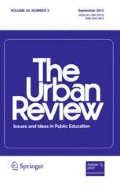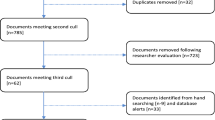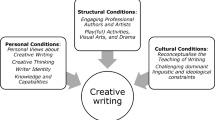Abstract
As the world becomes more digitized, visual content becomes commonplace in educational spaces. However, visual choices are not always accompanied with critical thought or awareness of the harmful messages or stereotypes connected to the images. The purpose of this study was to examine visual microaggressions embedded in the visual content of webiste projects created by preservice teachers (PSTs) for an education course. We qualitatively analyzed the images that PSTs (N = 97) included in a social issues website assignment and their written reflections on the images they incorporated. Additionally, six PSTs participated in focus group sessions where they reflected on images used across websites. A qualitative analysis of data led to the identification of visual microaggressions and deficit-thinking about children and families. Visual data portrayed children’s home lives as unsafe and unhappy, showed teaching as a white profession, endorsed white saviorism, and reinforced negative stereotypes about poverty. Focus group conversations led to critical visual literacy for some visual microaggressions, while individual reflections did not. Although PSTs in this study unintentionally enacted visual microaggressions in their projects, selected images can still cause harm. Implications for teacher education and schools are discussed.






Similar content being viewed by others
Data Availability
Data are confidentially stored for 5 years based on our university’s IRB guidelines.
References
Abel, E. (2010). Signs of the times the visual politics of Jim Crow. University of California.
Aronson, B. A. (2017). The white savior industrial complex: A cultural studies analysis of a teacher educator, savior film, and future teachers. Journal of Critical Thought and Praxis, 6(3), 36–54.
Asghar, J. (2013). Critical paradigm: A preamble for novice researchers. Life Science Journal, 10(4), 3121–3127.
Bazeley, P., & Jackson, K. (2007). Qualitative analysis with NVivo. Sage.
Berg, B. (1998). Qualitative research methods for the social sciences. Allyn and Bacon.
Bergen, M., & Mollen, D. (2019). Teaching sizeism: Integrating size into multicultural education and clinical training. Women & Therapy, 42(1-2), 164-180.
Blair, A. N., & Steele, J. R. (2010). Examining the consequences of exposure to racism for the executive functioning of Black students. Journal of Experimental Social Psychology, 46(1), 127–132.
Bolton, R. (1989). The contest of meaning. MIT Press.
Bomer, R. (2008). Miseducating teachers about the poor: A critical analysis of Ruby Payne’s claims about poverty. Teachers College Record, 110, 2497–2531.
Boyatzis, R. (1998). Transforming qualitative information: Thematic analysis and code development. Thousand Oaks: Sage.
Bowen, T. (2017). Assessing visual literacy: A case study of developing a rubric for identifying and applying criteria to undergraduate student learning. Teaching in Higher Education, 22(6), 705–719.
Bridges, L., & Edmunson-Morton, T. (2011). Image-seeking preferences among undergraduate novice researchers. Evidence-Based Library and Information Practice, 6(1), 24–40.
Brown, A. (2013). Waiting for Superwoman: White female teachers and the construction of the"neoliberal savior" in a New York City public school. Journal for Critical Education Policy Studies (JCEPS), 11(2).
Brumberger, E. (2011). Visual literacy and the digital native: An examination of the millennial learner. Journal of Visual Literacy, 30(1), 19–47.
Burden, P. R., & Byrd, D. M. (2013). Methods for effective teaching: Meeting the needs of all students (6th ed.). Pearson.
Chávez, L. R. (2001). Covering immigration: Popular images and the politics of the nation. University of California Press.
Cheruvu, R., Souto-Manning, M., Lencl, T., & Chin-Calubaquib, M. (2015). Race, isolation, and exclusion: What early childhood teacher educators need to know about the experiences of pre-service teachers of color. The Urban Review, 47(2), 237–265.
Chrisler, J. C., & Barney, A. (2017). Sizeism is a health hazard. Fat Studies, 6(1), 38–53.
Clark, R., Anderson, N. B., Clark, V. R., & Williams, D. R. (1999). Racism as a stressor for African Americans. American Psychologist, 54, 805–816.
Corbin, J., & Strauss, A. (2015). Basics of qualitative research: Techniques and procedures for developing grounded theory (4th ed.). Thousand Oaks, CA: Sage.
Dávila, A. (2008). Latino spin: Public image and the whitewashing of race. New York University.
DiAngelo, R. (2011). White fragility. International Journal of Critical Pedagogy, 3, 54-70.
Dee Smiley, A. & Helfenbein, R. J. (2011). Becoming teachers: The Payne effect. Multicultural Perspectives, 13(1), 5–15.
Drudy, S. (2008). Gender balance/gender bias: The teaching profession and the impact of feminisation. Gender and Education, 20(4), 309–323.
Ellis, J. M., Powell, C. S., Demetriou, C. P., Huerta-Bapat, C., & Panter, A. T. (2019). Examining first-generation college student lived experiences with microaggressions and microaffirmations at a predominately White public research university. Cultural Diversity and Ethnic Minority Psychology, 25(2), 266–279.
Emanuel, R., Baker, K., & Challons-Lipton, S. (2016). Images every American should know: Developing the cultural image literacy assessment-USA. Journal of Visual Literacy, 35(4), 215–236.
Endo, R. (2015). How Asian American female teachers experience racial microaggressions from pre- service preparation to their professional careers. The Urban Review, 47(4), 601–625.
Foley, D. (2008). Questioning “cultural” explanations of classroom behaviors. In M. Pollock (Ed.), Everyday antiracism: Getting real about race in school. New York and London: The New Press.
Freeman, T. (2006). ‘Best practice’ in focus group research: Making sense of different views. Journal of Advanced Nursing, 56(5), 491–497.
Frosh, P. (2003). The image factory: Consumer culture, photography and the visual content industry. New York, NY: Berg.
Gorski, P. (2008). The myth of the culture of poverty. Educational Leadership, 67(7), 32–36.
Gorski, P. C., Davis, S. N., & Reiter, A. (2013). An examination of the (in) visibility of sexual orientation, heterosexism, homophobia, and other LGBTQ concerns in US multicultural teacher education coursework. Journal of LGBT Youth, 10(3), 224–248.
Haddix, M. (2008). Beyond sociolinguistics: Towards a critical approach to cultural and linguistic diversity in teacher education. Language and Education, 22(5), 254–270.
Haddix, M., McArthur, S. A., Muhammad, G. E., Price-Dennis, D., & Sealey-Ruiz, Y. (2016). At the kitchen table: Black women English educators speaking our truths. English Education, 48(4), 380–395.
Harper, D. (2002). Talking about pictures: A case for photo elicitation. Visual Studies, 17(1), 13–26.
Harris, M. D. (2003). Colored pictures: Race and visual representation. University of North Carolina Press.
Hooks, B. (1994). Teaching to transgress: education as the practice of freedom. New York: Routledge.
Hunt, C. S. (2018). How do photographs represent issues of social class in educational media? Paper presented at the 14th International Congress of Qualitative Inquiry. Urbana, IL.
Keller, R. M., & Galgay, C. E. (2010). Microaggressive experiences of people with disabilities. In D. W. Sue (Ed.), Microaggressions and marginality: Manifestations, dynamics, and impacts (pp. 241–268). Wiley.
Kendi, I. X. (2019). How to be an antiracist. New York: Random House.
Kim, A. S., Choi, S., & Park, S. (2020). Heterogeneity in first-generation college students influencing academic success and adjustment to higher education. The Social Science Journal, 57(3), 288–304.
Kress, G., & Van Leeuwen, T. (2001). Multimodal discourse. Arnold.
Lin, A. I. (2010). Racial microaggressions directed at Asian Americans: Modern forms of prejudice and discrimination. In D. W. Sue (Ed.), Microaggressions and marginality: Manifestations, dynamics, and impacts (pp. 85–104). Wiley.
Lincoln, Y. S., & Guba, E. G. (1985). Naturalistic inquiry. Sage.
Lorsbach, A. W., & Lucey, T. A. (2015). The myths of who we are: Meritocracy, teachers, and perceptions of working-class family histories. Education and Society, 33(2), 65–83.
Love, B. L. (2019). We want to do more than survive: Abolitionist teaching and the pursuit of educational freedom. Beacon Press.
Luttrell, W. (2000). “ Good enough” methods for ethnographic research. Harvard Educational Review, 70(4), 499–523.
Lutz, C. & Collins, J. (1993). Reading National Geographic. Chicago: University of Chicago.
Martinez, R. (2016). Deficit vs. Appreciative perspectives of the language of young latin@ children. Paper presented at literacy research association conference, Nashville, TN.
Matias, C. E. & Zembylas, M. (2014). ‘When saying you care is not really caring’: Emotions of disgust, whiteness ideology, and teacher education. Critical Studies in Education, 55(3), 319–337.
Matias, C. E. (2016). Feeling white: Whiteness, emotionality, and education. Sense Publishers.
Matusiak, K. K., Heinbach, C., Harper, A., & Bovee, M. (2019). Visual literacy in practice: Use of images in students’ academic work. College & Research Libraries, 80(1), 123–139.
Mcgee, E. O. (2014). When it comes to the mathematics experiences of Black preservice teachers. Race matters. Teachers College Record, 116(6), 1–50.
Mercer, S. H., Zeigler-Hill, V., Wallace, M., & Hayes, D. M. (2011). Development and initial validation of the Inventory of Microaggressions Against Black Individuals. Journal of Counseling Psychology, 58(4), 457–469.
Milner, H. R., IV. (2010). What does teacher education have to do with teaching? Implications for diversity studies. Journal of Teacher Education, 61(1–2), 118–131.
Minikel-Lacocque, M. (2013). Racism, college, and the power of words: Microaggressions reconsidered. American Educational Research Journal, 50(3), 432–465.
Mitchell, W. T. (2008). Visual literacy or literary visualcy (pp. 11–29). In J. Elkins (Ed.), Visual literacy. Routledge.
Mitton, J., Tompkins, J., & Kearns, L. L. (2021). Exploring the impact of an anti-homophobia and anti-transphobia program on a teacher education program: LGBTQ pre-service teachers identify benefits and challenges. Alberta Journal of Educational Research, 67(1), 32–52.
Morrow, R. A., & Brown, D. (1994). Critical Theory and Methodology. Sage.
Nadal, K. L., Rivera, D. P., & Corpus, M. J. H. (2010b). Sexual orientation and transgender microaggressions: Implications for mental health and counseling. In D. W. Mitchell materials. English teaching: Practice and critique, 10(1), 81–94.
Nadal, K. L., Issa, M. A., Griffin, K. E., Hamit, S., & Lyons, O. B. (2010). Religious microaggressions in the United States: Mental health implications for religious minority groups. In D. W. Sue (Ed.), Microaggressions and marginality: Manifestations, dynamics, and impacts (pp. 287–312). Wiley.
National Center for Educational Statistics. (2019). Teacher characteristics and trends. Retrieved from Fast Facts: Teacher characteristics and trends (28) (ed.gov)
Newfield, D. (2011). From visual literacy to critical visual literacy: An analysis of educational materials. English Teaching: Practice and Critique, 10(1), 81–94.
Nieto, S., & Bode, P. (2012). Affirming diversity: The sociopolitical context of multicultural Education (6th ed.). Pearson.
Nóvoa, A. (2000). Ways of saying, ways of seeing - Public images of teachers (19th-20th Centuries). Paedagogica Historica, 36(1), 20–52.
Onwuegbuzie, A. J., Dickinson, W. B., Leech, N. L., & Zoran, A. G. (2009). A qualitative framework for collecting and analyzing data in focus group research. International Journal of Qualitative Methods, 8(3), 1–21.
Palmer, M. S. (2015). Learning to see the infinite: Teaching visual literacy in a first‐year seminar course. New Directions for Teaching and Learning, 2015(141), 19–29.
Pérez Huber, L., Camargo Gonzalez, L., & Solórzano, D. G. (2020). Theorizing a critical race content analysis for children’s literature about people of color. Urban Education, 0042085920963713.
Pérez Huber, L., & Solórzano, D. G. (2015). Visualizing everyday racism: Critical race theory, visual microaggressions, and the historical image of Mexican banditry. Qualitative Inquiry, 21(3), 223–238.
Pierce, C. (1974). Psychiatric problems of the black minority. American Handbook of Psychiatry, 2, 512–523.
Pierce, C. (1995). Stress analogs of racism and sexism: Terrorism, torture, and disaster. In C. Willie, P. Rieker, B. Kramer, & B. Brown (Eds.), Mental health, racism, and sexism (pp. 277–293). University of Pittsburgh Press.
Puhl, R. M. & King, K. M. (2013). Weight discrimination and bullying. Best Practice & Research: Clinical Endocrinology & Metabolism, 27(2), 117–127.
QSR International Pty Ltd. (2018). NVivo qualitative data analysis software; Version 12.
Reyes, X. A., & Rios, D. I. (2003). Imaging teachers: In fact and in the mass media. Journal of Latinos and Education, 2(1), 3-11.
Rose, G. (2016). Visual methodologies: An introduction to researching with visual materials. Sage.
Sarcedo, G. L., Matias, C. E., Montoya, R., & Nishi, N. (2015). Dirty dancing with race and class: Microaggressions toward first-generation and low-income college students of color. Journal of Critical Scholarship on Higher Education and Student Affairs, 2(1), 1.
Scott, S. V., & Rodriguez, L. F. (2015). “A fly in the ointment” African American male preservice teachers’ experiences with stereotype threat in teacher education. Urban Education, 50(6), 689–717.
Shankar, A. (2014). Towards a critical visual pedagogy: A response to the ‘end of poverty’ narrative. Visual Communication, 13(3), 341–356.
Simmons, D. (2019). How to be an antiracist educator. Retrieved from http://www.ascd.org/publications/newsletters/education-update/oct19/vol61/num10/How-to-Be-an-Antiracist-Educator.aspx
Sleeter, C. E. (2001). Preparing teachers for culturally diverse schools: Research and the overwhelming presence of whiteness. Journal of Teacher Education, 52(2), 94–106.
Smith, W. A., Allen, W. R., & Danley, L. L. (2007). “Assume the position. You fit the description” psychosocial experiences and racial battle fatigue among African American male college students. American Behavioral Scientist, 51(4), 551–578.
Smith, A. (2012). Indigeneity, settler colonialism, and white supremacy. In D.M. HoSang, LaBennett, O., & Pulido, L. (Eds.). (2012). Racial formation in the twenty-first century. Berkeley, CA: University of California Press.
Smith, L., & Redington, R. M. (2010). Class dismissed: Making the case for the study of classist microaggressions. In D. W. Sue (Ed.), Microaggressions and marginality: Manifestations, dynamics, and impacts (pp. 269–286). Wiley.
Smith, J. M., & Lucena, J. C. (2016). Invisible innovators: How low-income, first-generation students use their funds of knowledge to belong in engineering. Engineering Studies, 8(1), 1–26.
Solórzano, D., Ceja, M., & Yosso, T. (2000). Critical race theory, racial microaggressions, and campus racial climate: The experiences of African American college students. Journal of Negro Education, 60–73.
Solórzano, D. G., & Pérez Huber, L. (2012). Microaggressions, racial. In J. A. Banks (Ed.), Encyclopedia of diversity and education (pp. 1488–1491). Thousand Oaks, CA: SAGE.
Souto-Manning, M., & Winn, L. (2019). Toward shared commitments for teacher education: Transformative justice as an ethical imperative. Theory into Practice, 58(4), 308–317.
Suárez-Orozco, C., Casanova, S., Martin, M., Katsiaficas, D., Cuellar, V., Smith, N. A., & Dias, S. I. (2015). Toxic rain in class: Classroom interpersonal microaggressions. Educational Researcher, 44(3), 151–160.
Sue, D. W., & Constantine, M. G. (2007). Racial microaggressions as instigators of difficult dialogues on race: Implications for student affairs educators and students. College Student Affairs Journal, 26(2), 136–143.
Sue, D. W., Alsaidi, S., Awad, M. N., Glaeser, E., Calle, C. Z., & Mendez, N. (2019). Disarming racial microaggressions: Microintervention strategies for targets, White allies, and bystanders. American Psychologist, 74(1), 128–142.
Valencia, R. (2010). Dismantling contemporary deficit discourse and thinking. Routledge.
Van Galen, J. A. (2010). Class, identity, and teacher education. The Urban Review, 42(4), 253–270.
Weber, M. (1999). Ideal-Type Constructs. In W. Heydebrand & Max Weber (Eds.). Socio1logical Writings. New York: Continuum.
Williams, M. T. (2019). Adverse racial climates in academia: Conceptualization, interventions, and call to action. New Ideas in Psychology, 55, 58–67.
Williams, M. T. (2020). Microaggressions: Clarification, evidence, and impact. Perspectives on Psychological Science, 15(1), 3–26.
Wray, M. (2006). Not Quite White: White trash and the boundaries of whiteness. New York: Duke University Press.
Funding
Not applicable.
Author information
Authors and Affiliations
Contributions
K Miller and C Hunt were both involved in the collection, analysis and writing of the manuscript.
Corresponding author
Ethics declarations
Conflict of interest
There are no conflicts of interest.
Ethics Approval
IRB approval was gained through Illinois State University.
Consent to Participate
All participants completed and signed a consent form that detailed the study.
Consent for Publication
The consent form explained that research would lead to the dissemination of findings in presentations and journal articles.
Additional information
Publisher's Note
Springer Nature remains neutral with regard to jurisdictional claims in published maps and institutional affiliations.
Rights and permissions
About this article
Cite this article
Miller, K., Hunt, C. A Picture is Worth a Thousand Words: Visual Microaggressions in Teacher Education. Urban Rev 54, 674–702 (2022). https://doi.org/10.1007/s11256-022-00636-3
Accepted:
Published:
Issue Date:
DOI: https://doi.org/10.1007/s11256-022-00636-3




